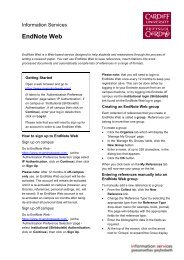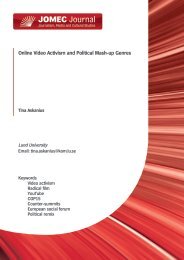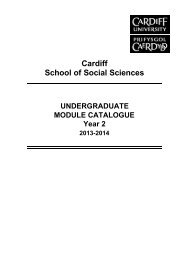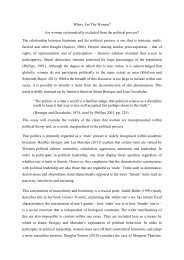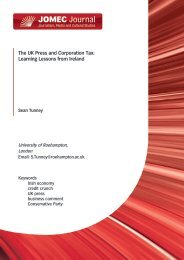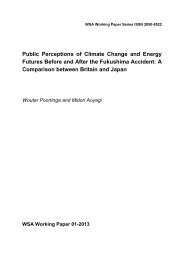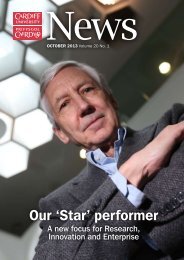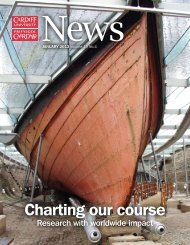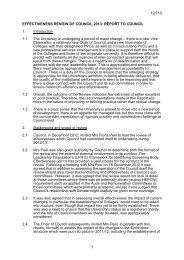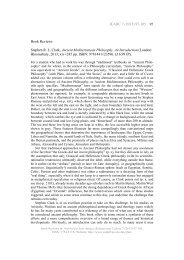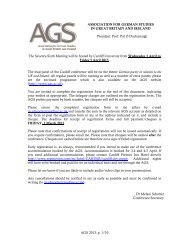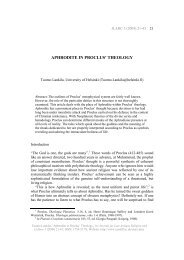pdf format - Cardiff University
pdf format - Cardiff University
pdf format - Cardiff University
You also want an ePaper? Increase the reach of your titles
YUMPU automatically turns print PDFs into web optimized ePapers that Google loves.
© B Adam – web complexity futures - 230905 2<br />
Complexity Theory for the Social sciences<br />
For the social sciences, complexity theory is a welcome change. Its root in mathematical and<br />
natural science perspectives gives it respectability. As socially revered ‘scientific’ (meaning<br />
‘hard’ science) knowledge, it can support and give credence to the more complex analyses of<br />
the social world. In other words, when the natural sciences and mathematics ‘discover’<br />
complexity, their ‘findings’ legitimate what have been inescapable features of cultural<br />
investigation and knowledge. To accommodate the public reverence for knowledge based on<br />
‘scientific evidence’, the socio-cultural sciences have had to squeeze the complexity of their<br />
living, creative, productive, innovative, questing, temporally extended, future oriented,<br />
knowledge based, reflexive, moral subject matter into a methodology designed for inanimate<br />
matter (dead things) in motion. To be recognised as a scientific enterprise they had to find<br />
ways to square the circle of social complexity and scientific reduction to simplicity and<br />
general laws.<br />
Complexity perspective, as it is applied to biological systems, allows for bringing into a<br />
coherent unity of analysis the material, spatial and temporal dimensions of existence. Material<br />
structure, spatial patterns of networked relations and temporal processes of becoming are<br />
given equal weight in the analysis. The material, spatial and temporal are seen as mutually<br />
implicating rather than mutually exclusive. For the social sciences this is a methodological<br />
quantum leap that takes scientific praxis out of the dark ages of binary opposites,<br />
reductionism and linear causality and reunites what had been so carefully prised apart. More<br />
revolutionary still, the temporal is given due recognition, with many of the key concepts of<br />
complexity theory having a decidedly temporal ring to them: ‘attractors’, ‘autopoiesis’,<br />
‘catalysis’, ‘co-evolution’, ‘emergent properties’, ‘dissipative structures’, ‘feedback loops’,<br />
‘interactive flows of exchange’, ‘iteration’, ‘non-linear dynamics’, ‘perturbation’ and<br />
‘synergy’ being just some of the more pertinent examples. When material structure, spatially<br />
networked relations and temporal processes are brought together in one analytical framework,<br />
context becomes an important consideration. It brings with it an implicit appreciation that<br />
each approach to investigations will need to be appropriate to its subject matter, that is, the<br />
knowledge sphere to which research and analysis are directed. Single cell or ganisms will<br />
require different conceptual and methodological tools from earthworms, forests different ones<br />
from social organisations and institutions. No one method will fit all. Once more, the<br />
complexity framework of analysis provides the social sciences with tremendous potential for<br />
scope and development.<br />
This much-appreciated increased scope, however, comes at a price. The complexity<br />
perspective increases uncertainty. It asks us to embrace it, to face up to it, to find new ways to<br />
engage with it. That is discomfiting and disconcerting stuff. Focus on complexity may be<br />
essential to better understand and cope with the contemporary world of our making but it<br />
leaves us more vulnerable and discomforted. It unsettles tried and trusted schemas of coping<br />
with the unknown. Thus, when politicians and funding bodies, for example, continue to<br />
hanker after the science of old and expect certainty, simplicity, and trustworthy evidence, they<br />
resist the loss of certainty that comes with a complexity perspective on the social world and<br />
the changes it introduces to the way the future has been handled for the past three hundred<br />
years. They want to retain the historically tempered deep structure of cultural engagement<br />
with the not yet and the unknown.<br />
Questions we need to ask in the context of this futures research project is whether the<br />
complexity perspective with its key components is adequate to the study and explanation of<br />
temporally extended human culture or whether socio-cultural futurity is a complexity too far.



